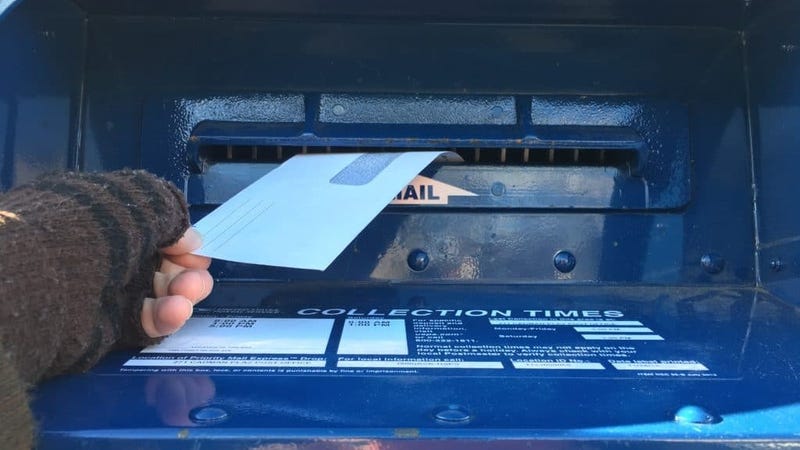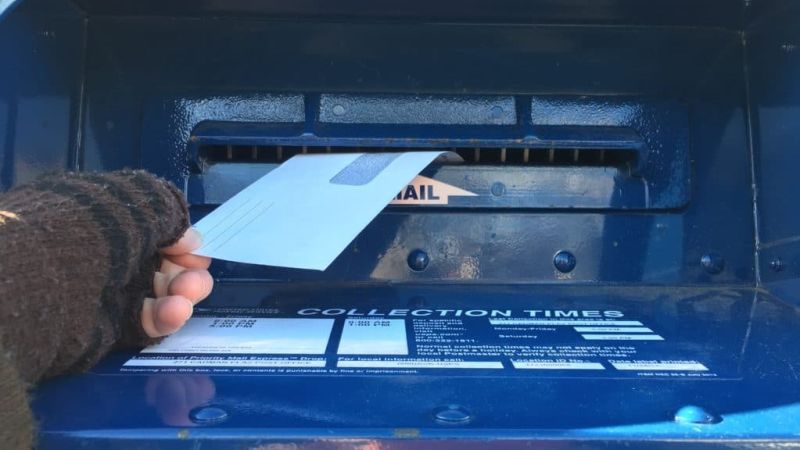
Depending on where you live, you may have noticed a new type of mailbox appearing on your local streets. At first glance, they look like the same signature blue boxes with rounded tops that the United States Postal Service has been using for decades. But if you try to mail a letter in one of them, you’ll find that the familiar hinged door has been eliminated. In its place is a narrow slot with a slatted barrier behind it, all of which is designed to make the box more tamper-proof.
These new mailboxes, which are being installed throughout much of the Northeast, are the worst. For starters, padded mailers and small packages won’t fit through the slot. But more importantly, the slot makes for a completely unsatisfying consumer experience. The old boxes featured the reassuring weight of the hinged door, the friendly squeak as the door opened and closed, and the reflexive ritual of reopening the door to make sure that letter had actually disappeared into the box. The slot offers no such pleasures. It’s a sadly sterile interaction.
Advertisement
The new boxes also take a certain psychological toll on the postal customer. It’s true, of course, that mail theft is a legitimate and longstanding problem (remember all those old Westerns where the bandits would rob the mail train?), and it’s good that the Postal Service is addressing it, but there’s something unsettling about being forced to think about that. Mailing a letter is already a tremendous act of faith—it’s kind of a miracle that we can just drop an illegibly scrawled envelope in a box and trust that it will end up where we want it to go. Once the Postal Service starts acknowledging that the box might not be secure, it becomes harder to maintain that suspension of disbelief.

Advertisement
As if to reinforce that issue, the new tamper-proof boxes have a warning decal that advises: “For the security of your mail, avoid putting mail in the box after the last posted pick-up time.” So now they’re basically saying it’s not safe to mail a letter—even in one of the new tamper-proof boxes! They might as well tell us there’s no Santa Claus. (Who, by the way, is a big Postal Service customer—are his mailboxes tamper-proof?) Still, it could be worse: When a box has been victimized too often by thieves, the Postal Service puts a large, imposing-looking lock on it, which sort of resembles a boot on a car wheel. Imagine seeing that on a mailbox in your neighborhood—could you ever trust the mail again?
I know, I know—who even mails a letter these days? And granted, America’s mailbox population has been declining for years, but mailboxes—which the Postal Service sometimes calls “collection boxes,” to distinguish them from the box where the letter carrier leaves your mail—remain an iconic fixture of our landscape. A Postal Service spokesperson says there are still 143,000 of them scattered across America: a coast-to-coast network of epistolary iconography and ubiquity, all rendered in precisely the same official shade of blue (which is specified, of course, in the Postal Service’s style guide).
Advertisement
But mailboxes weren’t always blue. According to an October 2000 memo from the Postal Service’s historian, mailbox colors from 1889 through the end of World War I were a rotating carousel of green, an “aluminum color,” “aluminum bronze,” and red (which sometimes caused confusion when people mistook red mailboxes for fire alarm boxes and police call boxes). For several decades after the war, the boxes were painted olive drab, a color still used for the relay boxes seen in large cities. It wasn’t until 1955 that Postmaster General Arthur Summerfield decreed that the boxes would be blue at the base and red on top, with white lettering. Solid blue followed in 1970 and has been the standard ever since.
That blue and red color scheme—the one used from 1955 to 1970—is featured in one of the more famous mailbox-centric moments in popular culture: the scene where Linus mails a letter to the Great Pumpkin in the 1966 animated TV special It’s the Great Pumpkin, Charlie Brown.
But as you can see in that video clip, Linus’ mailbox wasn’t one of the four-legged models traditionally used today. It was mounted on a post. This post- or pole-mounted style is sometimes referred to as a “Doremus box,” a reference to its inventor, Willard D. Doremus, who received a patent for the first version of the design in 1889. (The four-legged, rounded-top design, which was developed to accommodate larger parcels, wouldn’t debut until the early 1900s.) Assorted small refinements were made over the years, but the basic look of the pole-mounted box—which typically had an immensely satisfying counterweighted door, whose heft and solidity Linus could no doubt discern right through his blanket—remained largely unchanged. Some of these boxes were attached to utility poles and others had their own dedicated posts.
Advertisement
Linus presumably didn’t realize this, but the post-mounted style was already on its way to extinction by the time he sent his letter to the Great Pumpkin. An informative report entitled “Mail Collection Boxes: A Brief History” indicates that the Postal Service stopped ordering post-mounted boxes from its contractors in 1955, apparently because they were too small to handle packages. (Ironic, given that the new four-legged tamper-proof boxes are also package-proof.) From there, it was a slow but steady decline. “In 1962,” the report says, “109,263 post-mounted boxes were still in service. By 2016, the number had dwindled to 169.” Yikes.
Still, echoes of the mounted style can still be found here and there, because some of their posts were left behind and are still standing. There are four of them in my Brooklyn neighborhood, in fact—tapered monuments of pebbled concrete, still with their rusted metal brackets where the mailboxes were once affixed but now bereft of the boxes themselves. They look oddly naked and solitary, offering mute testimony to changing postal protocols.
Advertisement
But while the small, post-mounted box has disappeared, other configurations have arisen. In 1988, the Postal Service introduced two larger sizes: the “high density” (later renamed simply “large”) and the “jumbo.” These seem less like boxes than bins—characterless, industrial-size receptacles that lack the charm of a standard mailbox. One does not deposit mail in these; one simply dumps.
Advertisement
Meanwhile: See that triangular attachment on the jumbo box, which is designed to let motorists mail letters without leaving their cars? For years I’ve mentally referred to this accessory as a “spout” or a “funnel.” But while working on this article, I’ve learned that it is officially known as—wait for it—a snorkel. How great is that? The first snorkels were tested in Salt Lake City in 1939. The Postal Service experimented with a number of different designs before settling on the current version in 1953. (Also of note: There are snorkel-specific versions of the boot-like security locks.)
According to a Postal Service spokesperson, the average lifespan of a mailbox is “at least 20 years, possibly longer in some locations.” That may get you thinking, as I myself have often thought, “What do they do with old, decommissioned mailboxes, anyway? Wouldn’t it be cool to have one on my front porch, or on on my back deck, or in my hallway? Wouldn’t it make a great laundry hamper?” Alas, postal regulations stipulate that “Collection boxes […] must not be sold to the public. They must be destroyed by the owning Postal Service entity and sold as scrap.” Despite this prohibition, vintage boxes—both the four-legged and post-mounted variety—sometimes show up on the antiques market, although they tend to be rather pricey.
Advertisement
There’s one other type of mail collection format worth mentioning here, although it isn’t a box: the venerable mail chute, which can still be found in some buildings. Just as with a mailbox, using a mail chute is an act of faith, but with higher degrees of both risk (what if the envelope gets stuck between floors?) and reward (seeing something disappear down a chute is inherently pleasing).
Most of the mail chutes seen in American buildings, along with the ornate ground-floor boxes they feed into, carry the name “Cutler Mailing System,” a reference to the chute’s inventor, James Goold Cutler, who received a patent for the concept in 1883. The first of his chutes was installed in a building in Rochester, New York, the following year. According to the Smithsonian National Postal Museum (yes, there’s a Smithsonian National Postal Museum!), “The first mail chutes were limited to railroad stations and public buildings. By 1905, the postal service allowed mail chutes to be placed in hotels taller than five stories and in apartment houses with more than 50 residential apartments.”
Advertisement
The good news is that the prohibition on reselling retired mailboxes does not appear to apply to chutes, so chute components are relatively plentiful on the collectibles scene. The bad news is, you know, what the hell are going to do with a mail chute in your house or apartment?
The answer, happily, is that a section of mail chute looks pretty good on a wall, even if it’s not functional. And I should know—I’m speaking from experience. Sure, it doesn’t actually work. But like I said, mail is all about suspension of disbelief.
Advertisement
Paul Lukas is the founder/editor of Uni Watch and the author of Inconspicuous Consumption: An Obsessive Look at the Stuff We Take for Granted.













